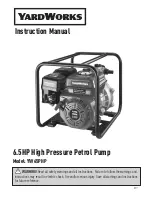
Using an Internal Mains transformer
Be afraid, be very afraid...
Some of you old hands will laugh about the level of hysteria that surrounds direct mains
connection to DIY projects. However, this fear is more to do with our litigious society than
the real danger to the builder. Even so, I have had more than my fair share of high voltage
shocks over the years and it is not something I would want any builder to have to experience.
It has been purely luck that has saved me in several of those cases.
So I will say again – do not attempt to build a mains transformer into your case, or any other
project, without realising that to do so carries a risk of death to either you, or to the person
who may inadvertently put their fingers into your half built construction. Furthermore, it is up
to you as the builder of such an item to make sure, that once built, the item is safe to use and
meets all current safety legislation.
This is not a complete set of instructions on how to fit a transformer into a piece of
electronic equipment. This information is offered only as a guide and should not be
considered as your only source of information. No further information, other than that
included here, will be provided by myself or Paul Darlow regarding the construction of
mains powered items.
For powering a HVM and an SE330 together then the mains transformer's secondaries should
be rated:
18-0, 18-0 (or 18-0-18)
30VA
This will give you a power supply that should be theoretically capable of providing just over
400mA to each rail assuming your heatsink and smoothing capacitors are up to the job.
The transformer secondary voltage is suggested to be 18V. It may be possible to use a
transformer rated at 15V. Most transformers produce more than their stated voltage when
drawing less than their maximum current and I have found that 15V toroids always work well
here in the UK. The benefit of using a lower secondary voltage is cooler power devices.
However, the disadvantage is that you may be running your power supply very close to its
lowest operating voltage – particularly if your country's line voltage is less than the expected
230V (or 110V).
Slightly higher transformer secondary voltages can also be tolerated although you need to
consider three things:
1. You may need a physically larger transformer for the same output power.
2. The power supply's components, including the smoothing capacitors, should be rated at a
high enough working voltage to handle the increased voltage across them.
10































